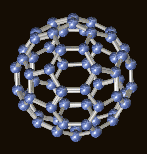
An issue important to all stakeholders in nanotechnology is the fate of nanomaterials in living systems and the environment. Water is a major medium of particulate transport in the environment and living systems, and fatty materials in living systems provide a reservoir in which nanomaterials can potentially bioaccumulate. New research by Professor Jafvert and doctoral student Kulkarni of Purdue University sheds light on the potential risk and fate of buckyball nanomaterial in the environment by examining both the relative potential for the buckyballs to partition in water or oil-like environments and the amount of buckyball material that can be dissolved in water. Buckyballs, also known as fullerenes and C60, are about one nanometer in diameter, made of carbon, and shaped like soccer balls. They are being investigated for use in drug delivery, as additives to composites for increased strength, and in chemical sensors and fuel cells.
This new research shows that buckyballs prefer to exist in the oil-like environments of octanol and toluene as compared with a water environment by a factor of 6.7 and 8.4, respectively. Also, Jafvert and Kulkarni found that buckyball solubility in water is quite low, and explain that the buckyballs will likely adsorb to solid surfaces, such as soils from the water phase. Furthermore, buckyballs will form clusters in water when their concentration increases above the solubility limit, complicating the determination of their eventual environmental fate. Through their investigation, they estimated bioconcentration factors for buckyballs in earthworms, cod and salmon. These estimations indicated that buckyballs are expected to accumulate in the fatty tissues of these organisms.
The authors cite remaining questions, including whether the buckyballs will degrade or be metabolized at a rate high enough to counter bioaccumulation, identification of degradation products, and toxicity of the bioaccumulated buckyballs or degradation products. Jafvert is currently looking into some of these questions, including the reactivity of buckyballs in the environment, and has found that they absorb light and photoreact, leading to the potential that they will degrade when exposed to sun or other light in the environment.
Information also available from R&D Magazine and Science Daily.
Image from Jafvert, C.T., Kulkarni, P.P., “Buckminsterfullerene’s (C60) Octanol-Water Partition Coefficient (KOW) and Aqueous Solubility” Environmental Science and Technology (2008) 42 (16), 5945-5950. Reprinted with permission from Dr. Roger Wagner.
